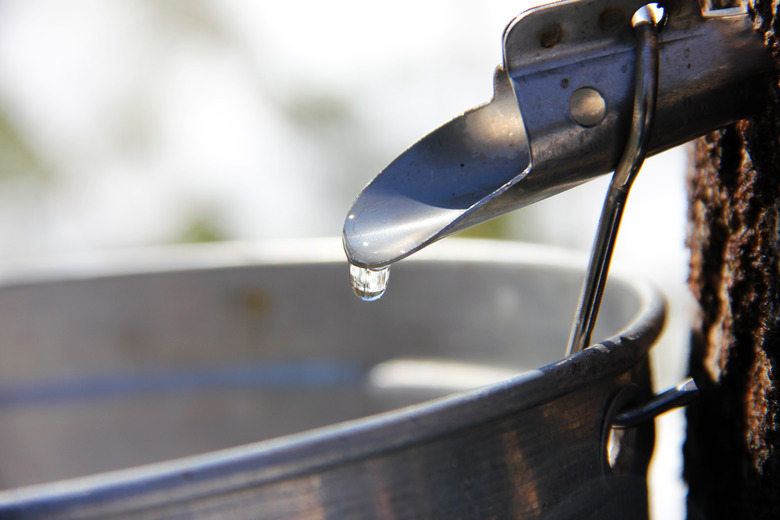The Difference Between Tree Sap & Tree Resin
Tree sap and tree resin are not the same. Maple syrup comes from maple trees in the form of sap that drips into a bucket hung from a spile or tap hammered into the tree. Deciduous trees do not produce resin, they produce sap. Sap is more watery than resin, which is thick and slightly amber color. Coniferous or evergreen trees like pine, cedar and Douglas fir produce both sap and tree resin.
TL;DR (Too Long; Didn't Read)
Most people confuse tree sap with tree resin. The two substances are significantly different in several ways. All trees produce sap to a considerable degree, but resin exists in the domain of trees that belong to the Pinaceae family of trees like pine, fir and cedar trees.
Properties and Uses
Properties and Uses
Sap is generally a relatively clear and thin watery substance, while resin, also called pitch, is an amber-colored, thick, gooey and tacky. Maple tree sap used to make maple syrup is essentially water with a mild, sweet taste. Maple sap also provides a source for potable drinking water straight out of the tap. Resin is a gummy material that looks and feels more like tacky, thick glue. Manufacturers use resin to make turpentine.
Resin and Sap Makeup
Resin and Sap Makeup
Tree sap exists in two basic forms. The tree pulls sap from the water in the soil through its trunk and out through its leaf pores called stomata. When the tree draws water from the soil, through its roots, it also pulls in mineral nutrients found in both the soil and water. Sap that flows from the leaves downward — generally toward the roots and other parts of the tree on its way — contains the all-important sugar or food the tree manufactured in its leaves during photosynthesis.
Resin is very different from sap in its composition. Rather than harboring nutrients that later get transported through the tree, resin consists of compounds secreted by or deposited in the tree. Scientists still don't agree as to whether resin in a tree acts as a waste product or is a means of protection against infection or insect attack.
Vascular Tissue Xylem
Vascular Tissue Xylem
A critically important tissue inside trees is vascular tissue. Trees contain two types of vascular tissue and both include sap. One type of vascular tissue is xylem that exists as a structural, as well as a sap-conducting tissue. Wood cut from the tree is essentially xylem, but ironically, many of the critically functioning cells in the xylem are dead. The shell formed by their cell walls and their empty interiors work a bit like tiny, interconnected straws to provide structural support and to simultaneously conduct sap up through the interior of the tree. Botanists have termed certain sections of the wood inside a tree as sapwood.
As the tree ages and increases in diameter, wood at the center of the trunk — wood that used to be sapwood — becomes heartwood as botanists and woodworkers call it. Heartwood gradually becomes clogged and ceases conducting sap while, at the same time, it accumulates some resins. Sap runs through xylem but primarily in the sapwood, while resins tend to accumulate in the heartwood when it ceases to transport sap.
Phloem Vascular Tissue
Phloem Vascular Tissue
The other vascular tissue in trees is phloem. In a tree trunk's cross section, the phloem is in a ring of tissue outside the xylem and is technically part of the tree's inner bark. Think of the phloem as the tree's food-conducting tissue. The xylem carries watery sap containing mineral nutrients upward, and the phloem carries sap, generally downward, laden with the all-important sugars the tree manufactures during photosynthesis.
Resin and Sap Function
Resin and Sap Function
Tree sap functions to transport vital mineral nutrients and sugars to all living parts of the tree. Because it is largely water, sap also serves to maintain turgor pressure. During the growing season, water continually flows from the tree's roots, up through the xylem and to the leaves.
This constant supply of watery sap inside the tree keeps leaves turgid — the opposite of wilted. Tree resin, since it is not conducted continuously through the tree's vascular tissue, contributes virtually nothing to turgor pressure and wilt prevention. Resin secreted and oozing through resin ducts, and often escaping through the bark of coniferous trees, serves more of a protective function in reaction to injury or attack by insects or pathogens.
References
Cite This Article
MLA
Miller, Donald. "The Difference Between Tree Sap & Tree Resin" sciencing.com, https://www.sciencing.com/difference-between-tree-sap-tree-resin-12296179/. 9 May 2018.
APA
Miller, Donald. (2018, May 9). The Difference Between Tree Sap & Tree Resin. sciencing.com. Retrieved from https://www.sciencing.com/difference-between-tree-sap-tree-resin-12296179/
Chicago
Miller, Donald. The Difference Between Tree Sap & Tree Resin last modified March 24, 2022. https://www.sciencing.com/difference-between-tree-sap-tree-resin-12296179/
